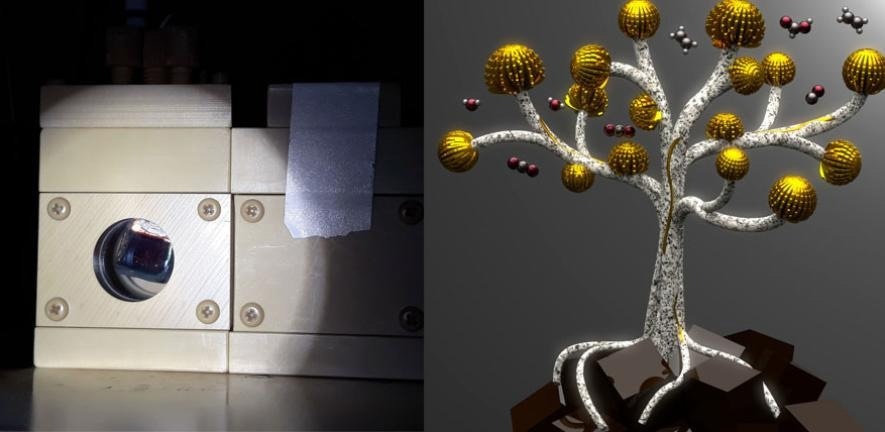Reviewed by Lexie CornerFeb 4 2025
A group of researchers from the University of Cambridge and the University of California, Berkeley, created a workable method for producing hydrocarbons, molecules composed of carbon and hydrogen, using only solar energy. The findings were published in the journal Nature Catalysis.
 Solar fuel generator. Image Credit: Virgil Andrei.
Solar fuel generator. Image Credit: Virgil Andrei.
The researchers developed a system that utilizes a copper nanoflower catalyst combined with a light-absorbing perovskite-based layer, similar to those used in high-efficiency solar cells, to convert carbon dioxide into useful molecules.
Unlike most metal catalysts, which primarily produce single-carbon molecules from CO2, the copper nanoflowers facilitate the formation of more complex hydrocarbons containing two carbon atoms, such as ethylene and ethane. These compounds are fundamental precursors for liquid fuels, chemicals, and plastics.
The Cambridge-Berkeley team’s process synthesizes hydrocarbons from CO2, water, and glycerol—an abundant organic compound—without generating additional carbon emissions. In contrast, most industrial hydrocarbon production relies on fossil fuel sources.
The study builds on previous work on artificial leaves, drawing inspiration from natural photosynthesis, where plants convert sunlight into chemical energy.
We wanted to go beyond basic carbon dioxide reduction and produce more complex hydrocarbons, but that requires significantly more energy.
Dr. Virgil Andrei, Study Lead Author, University of Cambridge
As part of the Winton Cambridge-Kavli ENSI Exchange program, Andrei, a Research Fellow at St John's College in Cambridge, conducted this research in Professor Peidong Yang's lab at the University of California, Berkeley.
By integrating the copper nanoflower catalyst with a perovskite light absorber, the team achieved the production of more complex hydrocarbons. To enhance efficiency and overcome the energy limitations of water splitting, they used silicon nanowire electrodes capable of oxidizing glycerol instead of water. This new platform demonstrates a 200-fold increase in hydrocarbon production efficiency compared to previous systems for CO2 and water conversion.
Beyond improving CO2 reduction performance, the reaction generates valuable byproducts such as formate, lactate, and glycerate, which have applications in chemical synthesis, pharmaceuticals, and cosmetics.
Glycerol is typically considered waste, but here, it plays a crucial role in improving the reaction rate. This demonstrates we can apply our platform to a wide range of chemical processes beyond just waste conversion. By carefully designing the catalyst’s surface area, we can influence what products we generate, making the process more selective.
Dr. Virgil Andrei, Study Lead Author, University of Cambridge
Although the current CO2-to-hydrocarbon selectivity is only about 10 %, the researchers hope that catalyst design will improve efficiency. By extending their platform to even more complex organic reactions, the team hopes to spur innovation in environmentally friendly chemical manufacturing. With further advancements, this research may hasten the shift to a carbon-neutral, circular economy.
This project is an excellent example of how global research partnerships can lead to impactful scientific advancements. By combining expertise from Cambridge and Berkeley, we have developed a system that may reshape the way we produce fuels and valuable chemicals sustainably.
Dr. Virgil Andrei, Study Lead Author, University of Cambridge
The study was funded in part by the Winton Programme for the Physics of Sustainability, St John’s College, the US Department of Energy, the European Research Council, and UK Research and Innovation (UKRI).
Journal Reference:
Andrei, V., et al. (2025) Perovskite-driven solar C2 hydrocarbon synthesis from CO2. Nature Catalysis. doi.org/10.1038/s41929-025-01292-y.